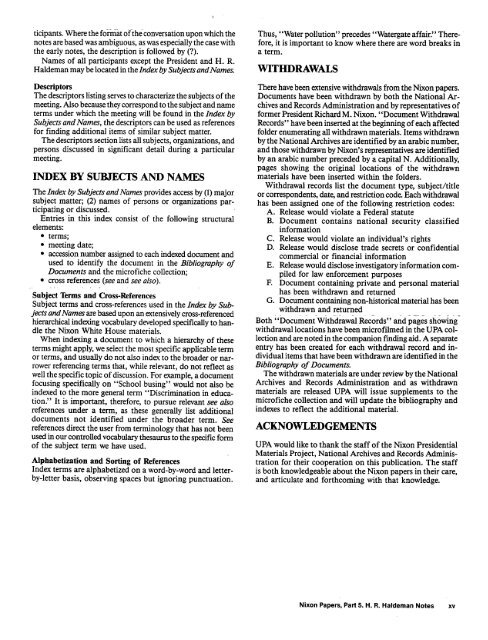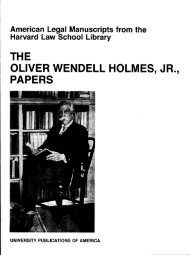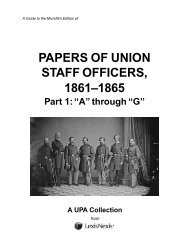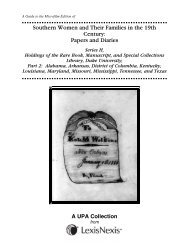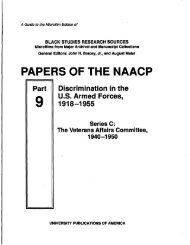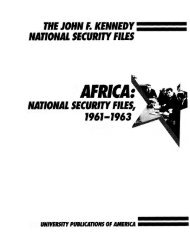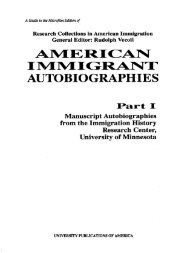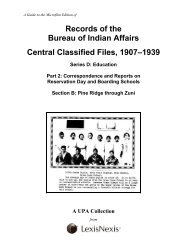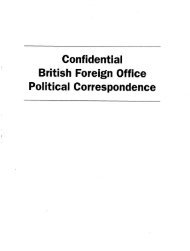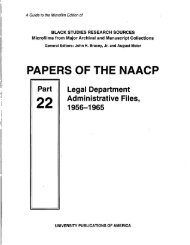guide - ProQuest
guide - ProQuest
guide - ProQuest
You also want an ePaper? Increase the reach of your titles
YUMPU automatically turns print PDFs into web optimized ePapers that Google loves.
ticipants. Where the format of the conversation upon which the<br />
notes are based was ambiguous, as was especially the case with<br />
the early notes, the description is followed by (?).<br />
Names of all participants except the President and H. R.<br />
Haldeman may be located in the Index by Subjects and Names.<br />
Descriptors<br />
The descriptors listing serves to characterize the subjects of the<br />
meeting. Also because they correspond to the subj ect and name<br />
terms under which the meeting will be found in the Index by<br />
Subjects and Names, the descriptors can be used as references<br />
for finding additional items of similar subject matter.<br />
The descriptors section lists all subjects, organizations, and<br />
persons discussed in significant detail during a particular<br />
meeting.<br />
INDEX BY SUBJECTS AND NAMES<br />
The Index by Subjects and Names provides access by (1) major<br />
subject matter; (2) names of persons or organizations par-<br />
ticipating or discussed.<br />
Entries in this index consist of the following structural<br />
elements:<br />
• terms;<br />
• meeting date;<br />
• accession number assigned to each indexed document and<br />
used to identify the document in the Bibliography of<br />
Documents and the microfiche collection;<br />
• cross references (see and see also).<br />
Subject Terms and Cross-References<br />
Subject terms and cross-references used in the Index by Sub-<br />
jects and Names are based upon an extensively cross-referenced<br />
hierarchical indexing vocabulary developed specifically to han-<br />
dle the Nixon White House materials.<br />
When indexing a document to which a hierarchy of these<br />
terms might apply, we select the most specific applicable term<br />
or terms, and usually do not also index to the broader or nar-<br />
rower referencing terms that, while relevant, do not reflect as<br />
well the specific topic of discussion. For example, a document<br />
focusing specifically on "School busing" would not also be<br />
indexed to the more general term "Discrimination in educa-<br />
tion." It is important, therefore, to pursue relevant see also<br />
references under a term, as these generally list additional<br />
documents not identified under the broader term. See<br />
references direct the user from terminology that has not been<br />
used in our controlled vocabulary thesaurus to the specific form<br />
of the subject term we have used.<br />
Alphabetization and Sorting of References<br />
Index terms are alphabetized on a word-by-word and letter-<br />
by-letter basis, observing spaces but ignoring punctuation.<br />
Thus, "Water pollution" precedes "Watergate affair." There-<br />
fore, it is important to know where there are word breaks in<br />
a term.<br />
WITHDRAWALS<br />
There have been extensive withdrawals from the Nixon papers.<br />
Documents have been withdrawn by both the National Ar-<br />
chives and Records Administration and by representatives of<br />
former President Richard M. Nixon. ' 'Document Withdrawal<br />
Records" have been inserted at the beginning of each affected<br />
folder enumerating all withdrawn materials. Items withdrawn<br />
by the National Archives are identified by an arabic number,<br />
and those withdrawn by Nixon's representatives are identified<br />
by an arabic number preceded by a capital N. Additionally,<br />
pages showing the original locations of the withdrawn<br />
materials have been inserted within the folders.<br />
Withdrawal records list the document type, subject/title<br />
or correspondents, date, and restriction code. Each withdrawal<br />
has been assigned one of the following restriction codes:<br />
A. Release would violate a Federal statute<br />
B. Document contains national security classified<br />
information<br />
C. Release would violate an individual's rights<br />
D. Release would disclose trade secrets or confidential<br />
commercial or financial information<br />
E. Release would disclose investigatory information com-<br />
piled for law enforcement purposes<br />
F. Document containing private and personal material<br />
has been withdrawn and returned<br />
G. Document containing non-historical material has been<br />
withdrawn and returned<br />
Both "Document Withdrawal Records" and pages showing<br />
withdrawal locations have been microfilmed in the UPA col-<br />
lection and are noted in the companion finding aid. A separate<br />
entry has been created for each withdrawal record and in-<br />
dividual items that have been withdrawn are identified in the<br />
Bibliography of Documents.<br />
The withdrawn materials are under review by the National<br />
Archives and Records Administration and as withdrawn<br />
materials are released UPA will issue supplements to the<br />
microfiche collection and will update the bibliography and<br />
indexes to reflect the additional material.<br />
ACKNOWLEDGEMENTS<br />
UPA would like to thank the staff of the Nixon Presidential<br />
Materials Project, National Archives and Records Adminis-<br />
tration for their cooperation on this publication. The staff<br />
is both knowledgeable about the Nixon papers in their care,<br />
and articulate and forthcoming with that knowledge.<br />
Nixon Papers, Part 5. H. R. Haldeman Notes xv


